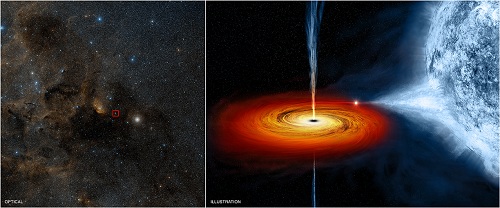Cygnus X-1 is one of the strongest X-ray sources we can detect from Earth and the first widely thought to be a black hole. In fact, when Stephen Hawking bet against X-1 being a black hole back in 1975, he was more or less setting up a hedge, for black holes have been a crucial part of Hawking’s work. Hawking writes about his wager with Kip Thorne entertainingly in the first edition of his A Brief History of Time (1988):
This was a form of insurance policy for me. I have done a lot of work on black holes, and it would all be wasted if it turned out that black holes do not exist. But in that case, I would have the consolation of winning my bet, which would win me four years of the magazine Private Eye. If black holes do exist, Kip will get one year of Penthouse. When we made the bet in 1975, we were 80% certain that Cygnus was a black hole. By now, I would say that we are about 95% certain, but the bet has yet to be settled.
Not long afterwards, the bet would be settled. If you go on to look at Thorne’s Black Holes and Time Warps (1994), you’ll find that Hawking found a way to get into Thorne’s office at Caltech while the latter was overseas, signing the bet he found framed on the wall as a way of indicating he conceded. Thus the bet ended, Thorne received Penthouse and Hawking was out all those issues of Private Eye, although it would not be completely accepted — even by Thorne — that Cygnus X-1 was a black hole until the release of three new papers.
The new work draws on data from a wide variety of instruments. Optical observations of the unseen black hole’s motion around the massive blue companion star it orbits yield the most precise determination of the mass of Cygnus X-1 ever made — the asteroid-sized body is 14.8 times the mass of the Sun, making it one of the most massive stellar black holes in the galaxy. Moreover, data from the Chandra X-ray Observatory, the Rossi X-ray Timing Explorer, and the Advanced Satellite for Cosmology and Astrophysics reveal that the black hole’s event horizon is spinning more than 800 times per second, a spin as fast as any that have been analyzed.
Image: On the left, an optical image from the Digitized Sky Survey shows Cygnus X-1, outlined in a red box. Cygnus X-1 is located near large active regions of star formation in the Milky Way, as seen in this image that spans some 700 light years across. An artist’s illustration on the right depicts what astronomers think is happening within the Cygnus X-1 system. Cygnus X-1 is a so-called stellar-mass black hole, a class of black holes that comes from the collapse of a massive star. The black hole pulls material from a massive, blue companion star toward it. This material forms a disk (shown in red and orange) that rotates around the black hole before falling into it or being redirected away from the black hole in the form of powerful jets. Credit: Optical: DSS; Illustration: NASA/CXC/M.Weiss.
The precise spin and mass findings relied on new estimates of the distance of this object using the National Radio Observatory’s Very Long Baseline Array, which pegged the black hole at 6,070 light years from Earth. The relatively slow motion of Cygnus X-1 through the Milky Way implies, according to this Chandra news release, that the black hole was not produced by a supernova, but may have been the result of a massive star that collapsed without an explosion.
All of this is enough to convince Kip Thorne, who had still entertained doubts:
“For forty years, Cygnus X-1 has been the iconic example of a black hole. However, despite Hawking’s concession, I have never been completely convinced that it really does contain a black hole — until now,” said Thorne. “The data and modeling described in these three papers at last provide a completely definitive description of this binary system.”
All three of the papers on this work are in press at the Astrophysical Journal. The papers are Reid et al., “The Trigonometric Parallax of Cygnus X-1” (preprint); Orosz et al., “The Mass of the Black Hole in Cygnus X-1” (preprint); and Gou et al., “The Extreme Spin of the Black Hole in Cygnus X-1” (preprint).




Visualizing evidence of a black hole
http://blogs.sas.com/content/sastraining/2012/07/31/visualizing-evidence-of-a-black-hole-with-a-gif-animation/